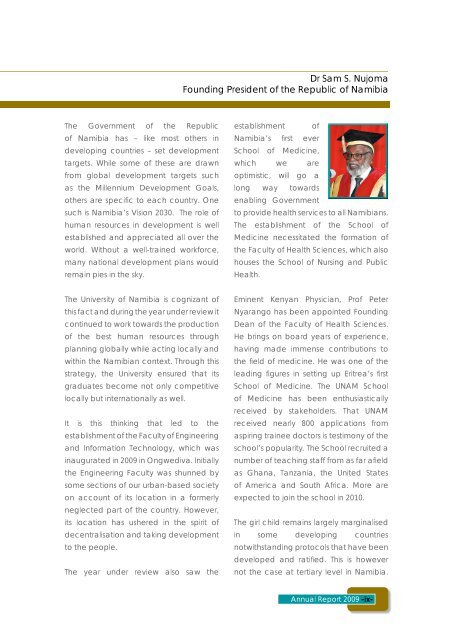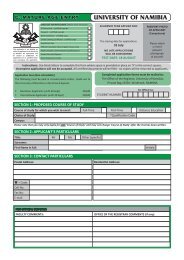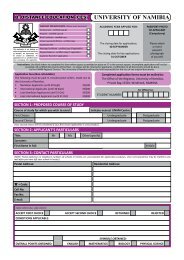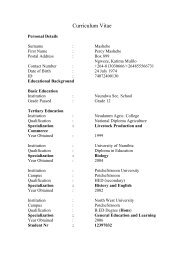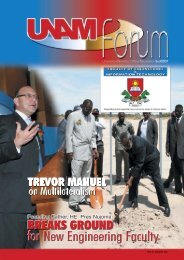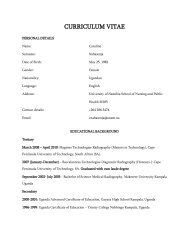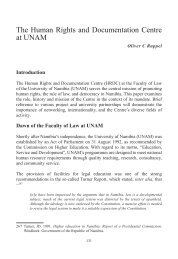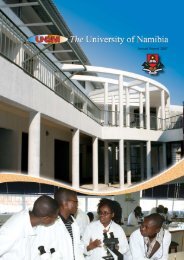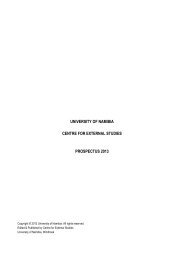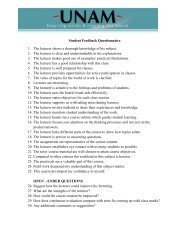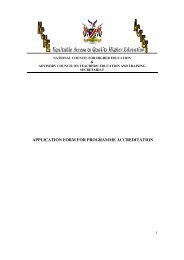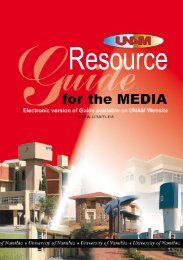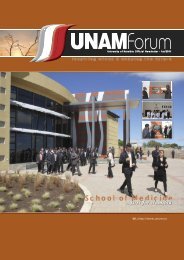Annual Report - University of Namibia
Annual Report - University of Namibia
Annual Report - University of Namibia
- No tags were found...
You also want an ePaper? Increase the reach of your titles
YUMPU automatically turns print PDFs into web optimized ePapers that Google loves.
Dr Sam S. NujomaFounding President <strong>of</strong> the Republic <strong>of</strong> <strong>Namibia</strong>The Government <strong>of</strong> the Republic<strong>of</strong> <strong>Namibia</strong> has – like most others indeveloping countries – set developmenttargets. While some <strong>of</strong> these are drawnfrom global development targets suchas the Millennium Development Goals,others are specifi c to each country. Onesuch is <strong>Namibia</strong>’s Vision 2030. The role <strong>of</strong>human resources in development is wellestablished and appreciated all over theworld. Without a well-trained workforce,many national development plans wouldremain pies in the sky.establishment <strong>of</strong><strong>Namibia</strong>’s fi rst everSchool <strong>of</strong> Medicine,which we areoptimistic, will go along way towardsenabling Governmentto provide health services to all <strong>Namibia</strong>ns.The establishment <strong>of</strong> the School <strong>of</strong>Medicine necessitated the formation <strong>of</strong>the Faculty <strong>of</strong> Health Sciences, which alsohouses the School <strong>of</strong> Nursing and PublicHealth.The <strong>University</strong> <strong>of</strong> <strong>Namibia</strong> is cognizant <strong>of</strong>this fact and during the year under review itcontinued to work towards the production<strong>of</strong> the best human resources throughplanning globally while acting locally andwithin the <strong>Namibia</strong>n context. Through thisstrategy, the <strong>University</strong> ensured that itsgraduates become not only competitivelocally but internationally as well.It is this thinking that led to theestablishment <strong>of</strong> the Faculty <strong>of</strong> Engineeringand Information Technology, which wasinaugurated in 2009 in Ongwediva. Initiallythe Engineering Faculty was shunned bysome sections <strong>of</strong> our urban-based societyon account <strong>of</strong> its location in a formerlyneglected part <strong>of</strong> the country. However,its location has ushered in the spirit <strong>of</strong>decentralisation and taking developmentto the people.The year under review also saw theEminent Kenyan Physician, Pr<strong>of</strong> PeterNyarango has been appointed FoundingDean <strong>of</strong> the Faculty <strong>of</strong> Health Sciences.He brings on board years <strong>of</strong> experience,having made immense contributions tothe fi eld <strong>of</strong> medicine. He was one <strong>of</strong> theleading fi gures in setting up Eritrea’s fi rstSchool <strong>of</strong> Medicine. The UNAM School<strong>of</strong> Medicine has been enthusiasticallyreceived by stakeholders. That UNAMreceived nearly 800 applications fromaspiring trainee doctors is testimony <strong>of</strong> theschool’s popularity. The School recruited anumber <strong>of</strong> teaching staff from as far afi eldas Ghana, Tanzania, the United States<strong>of</strong> America and South Africa. More areexpected to join the school in 2010.The girl child remains largely marginalisedin some developing countriesnotwithstanding protocols that have beendeveloped and ratifi ed. This is howevernot the case at tertiary level in <strong>Namibia</strong>.<strong>Annual</strong> <strong>Report</strong> 2009 -ix-


